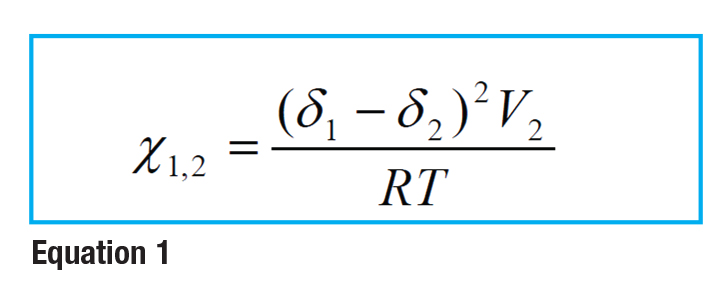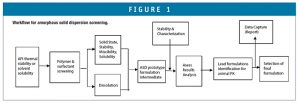Issue:June 2019
FORMULATION FORUM - Amorphous Formulations for Insoluble Drugs: Rational Design & Practical Approaches on Formulation Screening & Development
For poorly water-soluble “brick dust compounds” (Classes II and IV) characterized as high molecular weights, large log P values, and poor water solubilities, the drug absorptions process is often limited by the drug solubility or dissolution rate from the dosage forms. The bioavailability and absorption rate of those compounds into human body can be significantly improved by: 1) an increase in effective dissolution surface area by particle size reduction to the micron or the nanometer size range or by increasing wettability of the hydrophobic drugs, and 2) improvement in the solubility by formation of amorphous nanoparticles or amorphous solid dispersions that form nanoparticles in situ in the GI fluids. However, a comprehensive understanding of amorphous properties and their relationship with in vivo performance are still lagging. Development of characterization techniques to elucidate the structure of amorphous materials, prediction of in vitro and in vivo performance, and custom design of amorphous formulations has remained as the three major needs for the development of an amorphous drug delivery system. The issues associated with amorphous formulations include solid state stability, chemical stability, reproducibility of API manufacturing, impurity of API, stability in aqueous solution, in vitro in vivo performance, process and scale-up, etc.
AMORPHOUS DRUG DELIVERY SYSTEMS
Amorphous API
If the amorphous API can be reproducibly manufactured, and it possesses characteristics that could maintain its physical-chemical properties during process, storage, and in vivo physiological conditions, eg, a high transition point, (Tg-Tstorage > 50°C), strong glass former, non-hygroscopicity, and ability to maintain supersaturation in GI fluid within the transition time period without recrystallization, the amorphous API could be directly incorporated into the dosage forms by traditional formulation technologies and maintain its stability within the product shelf-life. For example, Crestor® (rosuvastatin calcium) tablets marketed by AstraZeneca contain amorphous API that is stable during manufacturing and storage conditions.
Amorphous Solid Dispersion
However, because most low-molecular-weight pharmaceutical APIs form a fragile glass, which has a Tg of < 75°C, and readily recrystallize out during storage or in vivo dissolution, it is often necessary to utilize excipients, eg, polymer or surfactant, to form a multiple-component amorphous system (ie, amorphous solid dispersion) in order to stabilize and inhibit the amorphous drug from crystallization at its solid or aqueous states. The introduction of stabilizing agents into the multiple-component amorphous system would not only optimize the stability of the amorphous drugs, but also improve the in vivo functionality and handling of the amorphous dosage form, eg, a reduction in stickiness, powder flow properties, moisture scavenging and protection, requirement in storage conditions, and packaging, etc.
Amorphous Nanoparticles
Amorphous nanoparticles are a combination of nanosizing and amorphous dispersion formation that theoretically could achieve the maximum enhancement in solubility and dissolution rate. It typically contains drug and polymers, surfactants, carriers, and other stabilizer(s). Amorphous drug nanoparticles can be prepared by a bottom-up process, high-shear mixing, high-pressure homogenization, or combination of a bottom-up process with a nanosizing process. Drug is dissolved in organic solvent(s) together with other stabilizer excipients, which is induced to precipitate out by introduction of non-solvent(s). Variation of formulation and process parameters can generate amorphous drug nanoparticles of different sizes that can be further incorporated into dosage forms by a downstream process.
RATIONAL DESIGN OF AMORPHOUS FORMULATION
To take advantage of the higher solubility of amorphous solids and to mitigate risks associated with physical instability, an understanding of molecular structure of amorphous materials and their relationship with the physical-chemical properties is essential for development of stable amorphous dosage forms. Two of the physical properties that are especially important to physical stability of amorphous solid dispersions are the drug-polymer miscibility and the solid solubility of the drug in polymeric matrices. Miscibility refers to capability of mixing two liquids in any ratio without separation of two phases, while solubility is defined as “the spontaneous interaction of two or more substances to form a homogenous molecular dispersion.”1 An understanding of these two properties will help in selecting an appropriate polymer and surfactant and determining an optimal amorphous drug-loading level for rational design of a stable amorphous solid dispersion formulation.
Drug-Polymer Miscibility
The extent of interaction between drug and polymer (interaction parameter, X1,2) is defined as the difference in solubility parameter between solute and solvent. See equation 1.

According to a miscibility study conducted by Greenhalgh et al on molten drugs and excipients possessing various solubility parameters, there is a trend in terms of increasing the degree of immiscibility with increasing the difference in the solubility parameter between drug and carrier.2 The difference in solubility parameters could give an indication of the potential miscibility between the drug and the polymer in solid dispersions (Table 1). One of the methods for determination of drug-polymer interaction parameter is melting-point depression method as described by Taylor et al.3

Drug Solid Solubility in Polymer
Due to the lengthy time period required to achieve equilibrium due to the glassy nature of most pharmaceutical solid dispersion systems, it is often challenging to determine the equilibrium of drug solid solubility in a polymer. For practical reasons, the pharmaceutical industry commonly determines the kinetic solid solubility of drug within a polymer using X-ray powder diffractometry (XRPD) and thermal analysis methods. Other qualitative techniques, such as Hot-stage microscopy, scanning electron microscopy (SEM), Raman spectroscopy, Fourier-transform infrared (FTIR) spectroscopy, solid-state nuclear magnetic resonance (SSNMR) spectroscopy, etc, are normally used to confirm the physical state observed by XRPD and differential scanning calorimetry (DSC).
AMORPHOUS FORMULATION SCREENING & IN VITRO EVALUATION
The primary goals of a screening study are to find a formulation of polymer and/or surfactant that is physically miscible and chemically compatible with drug, can load a reasonable amount of drug in a matrix, and enhance solubility and absorption of compound in vitro and in vivo. For a screening study, a solvent evaporation method can be utilized in combination with a miniature design that minimizes the amount of compound usage while allowing for screening enough quantity of formula by a DOE design. Samples can be prepared using 96-well plate, bottles, or vials with a flash drying of solvent under vacuum, heat, and/or inner gas. Potential lead formulations can then be optimized and manufactured on a larger scale for testing, including physical and chemical stability studies, in vitro release characterization, and in vitro studies in animals. Excipients can be selected from HPMC, PVP, PVPVA, PEG, HPC, Kollicoat IR, polymethyl acrylate, HPMCAS, Poloxamer, SoluPlus, hydropropyl methylcellulose phthalate, Cyclodextrin, Polysorbate, TPGS, AOT, SLS, Gelucire 44/14, etc, for screening of drug-polymer miscibility, stability, solubility, and dissolution.
A typical workflow for amorphous solid dispersion screening consists of the following elements:
-API thermal stability tests or solvent solubility
-Polymer/surfactant screening by drug-polymer miscibility, solid solubility, dissolution, and stressed stability
-Identification of prototype formulations and scale-up
-Characterization of prototype formulations by assay/related substance, polarized microscopy, KF, GC, DSC, SEM, XRPD, and in vitro dissolution using conditions simulating GI transition from gastric to intestine
-Animal PK study of prototype formulations, and feedback to formulation optimization based on animal study results
-Short-term stability testing at various temperature and humidity conditions to predict long-term shelf-life
-Lead formulation recommendation and data capture with a report
PROCESS TECHNOLOGY SELECTION
Selection of process technology for amorphous formulation depends on the compound properties. For example, API melting point, thermal stability, and solvent solubility will determine the processability of drug compound either by hot-melt extrusion (HME) or spray-drying process. Table 2 lists examples of commercial products and process technology utilized. Due to kinetic nature of amorphous materials, the performance of amorphous formulation will be affected by the selected technology and the process parameters.
Spray-drying is a well-established and widely used process for transforming formulation in liquid solutions or suspensions into dry powdered forms that is suitable for heat-sensitive compounds. Phase separation of drug and polymer could be prevented by rapid removal of solvent from the droplets of the spray solution and thereby rapid solidification of the droplets. HME has advantages in a simple continuous process with fewer manufacturing steps that could be useful for low-melting compounds with low-solvent solubility.
Liquid filling technologies for direct encapsulation of melt solid dispersions into hard capsules has gained popularity. The manufacturing of this amorphous dosage form involves the dissolving of drugs in melted carriers and the filling of the solutions into hard gelatin capsules. Lipid-based solid dispersion systems developed by this technology have been used in drug discovery and development.
DOSAGE FORM DEVELOPMENT AT DIFFERENT STAGES OF DEVELOPMENT
For preclinical studies or early phase clinical studies, aqueous suspensions of amorphous formulations after reconstitution are ideal for dosing for DMPK and toxicological evaluation. Studies should be done to ensure that amorphous formulations will not crystallize out in the aqueous suspension during the study period. Optimization in drug loading and polymer/surfactant level to inhibit compound crystallization may need to be undertaken to overcome the issue.
Powder in hard gelatin capsules is preferred for larger animals and early phase human trials, which has longer term stability than the reconstituted aqueous suspension. However, gelling may frequently occur inside the capsules during dissolution that may compromise the drug performance in vivo.
Tablets are the most preferred dosage form for late-stage and commercialization of amorphous materials. Spray dried amorphous powders will require secondary drying to remove the residual solvent and dry granulation by roller compaction to increase density. Amorphous formulation intermediates made by spray drying after dry granulation, HME, or solvent-evaporation processes requires milling to optimize the granule particle size distribution prior to further processing to ensure in vivo dissolution performance, flowability, and tabletability. Amorphous tablet formulation typically requires additional super-disintegrants, fillers, lubricants, and glidants in order to ensure manufacturability and rapid disintegration of the tablets. In addition, effects of excipient’s moisture level and hygroscopicity, and compression force on the amorphous stability will need to be evaluated.
REFERENCS
- Martin, A., Bustamante, P., Chun, A., editors. 1993, Solubility and Distribution Phenomena. In Physical Pharmacy 4th ed., Philadelphia: Lippincott William &Wilkins., p223- 224.
- Greenhalgh, D., Williams, A.C., Timmins, P., York, P., 1999, Solubility parameters as predictors of miscibility in solid dispersions, J. Pharm. Sci., 88: 1182-1190.
- Marsac, P.J., Shamblin, S.L., Taylor, L. S., 2006, Theoretical and Practical Approaches for Prediction of Drug-Polymer Miscibility and Solubility, Pharmaceutical Research, 23 (10):2417-2426.
To view this issue and all back issues online, please visit www.drug-dev.com.

Jim Huang, PhD
Founder & CEO
Ascendia Pharmaceuticals
j.huang@ascendiapharma.com
www.ascendiapharma.com
Total Page Views: 6922












